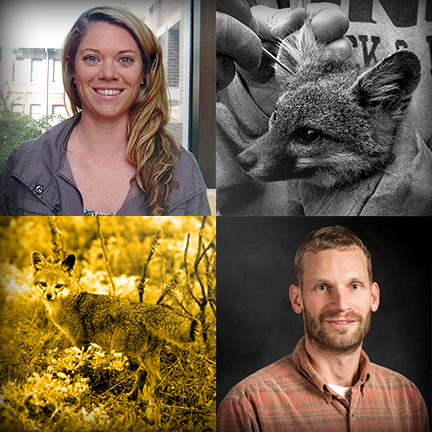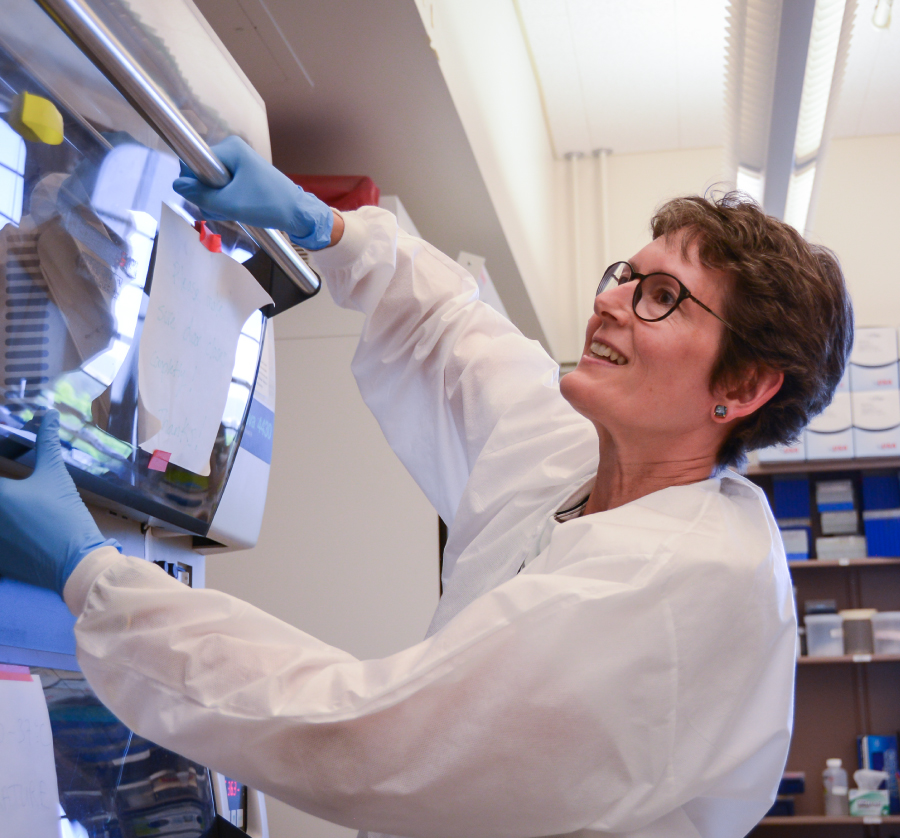
Not So Slow After All
Researchers from the Parent Lab in the Biological Sciences Department recently published a paper in the Journal of Heredity about the colonization and speciation sequence in Galapagos endemic land snails. Contributors include U of I researchers and grad students, as well as students and faculty from other universities.

Satellites on the Homestead
The RangeSAT project is a collection of user-based web tools for ranchers & land managers that aims to improve land management practices for grazing. It uses vegetation information from satellite imagery to help farmers sustainably graze their livestock. This project embodies collaboration between researchers, ranchers, and organizations in many fields.

Grad Student Develops Program to Increase Accuracy of Community Formation Processes
Ph.D. candidates Megan Ruffley, Katie Peterson, and Bob Week recently had a paper published in Ecology and Evolution titled “Identifying Models of Trait-Mediated Community Assembly Using Random Forests and Approximate Bayesian Computationâ€. This publication is the second chapter of Ruffley’s dissertation and the culmination of her lab rotation in Luke Harmon’s lab.

Getting the Timing Right
Undergraduate researcher Courtney Schreiner, from Scott Nuismer's lab, just had her first paper published in the British Ecological Society’s Journal of Applied Ecology—no small feat for an undergraduate student. Schreiner’s paper entails her research on the timing of vaccinations for wildlife populations. Many infectious diseases in humans and domesticated animals come from wildlife populations, hence the importance of studies like these.

Jill Johnson Receives $1 Million NIH Grant
Jill Johnson from the Biological Sciences department was awarded a 1 million dollar NIH grant. The grant is the result of an IBEST-funded pilot project, and will allow her to further study the Hsp90 function. Hsp90 is a global cellular regulator that controls the function of up to 15% of all cellular proteins, including many proteins that drive cancerous cell growth. Drugs that target Hsp90 block the function of cancer-causing proteins and stop tumor growth but are too toxic for general use. With this grant, Johnson and her collaborators hope to provide research that aids in the development of more selective and less toxic Hsp90-inhibiting drugs.

Domestic Sheep Swabbed for Movi Bacteria
Wrestling sheep on a cold morning in order to swab their noses may sound strange, but what researchers learn from these swabs could help protect the sheep in the long run. Kim Andrews from the GRC took nasal swabs from over 75 young sheep on October 17, with the help of the University of Idaho Sheep Center team and Thibault Stalder from Eva Top's lab. These samples will soon be tested for Mycoplasma ovipneumoniae (Movi). This is the beginning of a study that aims to eventually aid in the creation of a vaccine to protect sheep against the Movi bacteria.

Bacteria in the Human Vagina that Produce D-Lactic Acid Promote Resistance to Chlamydial Infections
Department of Biological Sciences Distinguished Professor Dr. Larry Forney, in collaboration with researchers from the University of Maryland, recently published a paper entitled “The cervicovaginal microbiota-host interaction modulated Chlamydia trachomatis infection†in the journal mBio that detailed their most recent study of the vaginal microbiome. Their research revealed mechanisms by which D-lactic acid produced by bacteria in the vagina might help protect women against Chlamydia trachomatis. These findings may enable the development of novel microbiome-based therapeutic strategies to protect women from infections and improve vaginal and cervical health.

Polymorphic Games Receives Grant for Evolutionary Mobile Game
Professor Barrie Robison recently received a $74,700 IGEM grant from the Idaho State Board of Education. He and co-PI Terence Soule will use the grant to create a mobile version of the first game produced by the Polymorphic Games Studio, entitled “Darwin’s Demonsâ€. The new version of Darwin’s Demons, will bring evolutionary procedural content generation into the world of mobile gaming. This technique uses evolutionary models to evolve original game content as the game progresses rather than relying on pre-programmed content—an innovative programming approach developed by Polymorphic Games. The studio has released two commercial games so far that utilize evolutionary procedural content generation, and both games get more difficult over time as the opponents’ appearance, behavior, and traits adapt to the choices and strategy of the player.

Paul Rowley Interviews with IDH About Novel Antifungal Proteins
Dr. Paul Rowley of the Biological Sciences department was recently interviewed by the Infectious Diseases Hub about his work exploring novel antifungal proteins. With rising resistance to antifungals, there is a need for new approaches and new drugs to treat fungal infections. In his interview, Rowley speaks about his research identifying novel antifungal proteins from Saccharomyces cerevisiae yeasts and whether these could be translated into the medications of the future.

Graduate Brings Ear Cancer in Channel Island Foxes to Light
Sarah Hendricks spends her days analyzing white rhino genomes at the San Diego Zoo Institute for Conservation Research as part of a program aimed at keeping the animals from extinction. She uses ground-breaking genetic techniques to assess, observe, and manage endangered species and prevent species extinction. It's the perfect job for Hendricks, who graduated from the University of Idaho in spring 2019 with a PhD in Bioinformatics and Computational Biology. As a U of I student, Hendricks went to Paul Hohenlohe, associate professor of evolutionary biology in the Department of Biological Sciences, and asked him if she could research the genetics of the foxes. Hohenlohe, who does similar work with Tasmanian devils, readily agreed. "While studying facial cancer in Tasmanian devils, my team found individual devils with tumor regression," Hohenlohe said. "The DNA sequencing of these individuals identified a gene that could play a role in that. Sarah and I believed that there might be something comparable happening with the foxes."

DARPA Visits the University of Idaho on October 9th
U.S. Defense Advanced Research Projects Agency (DARPA) program officials from the Biological Technologies Office (BTO), the Defense Sciences Office (DSO) and the Information Innovation Office (I2O) will be on the U of I Moscow campus Wednesday, Oct. 9, for an all-day event where faculty members and others can learn about research funding opportunities.

Faculty Success Seminar Schedule Announced
The Research and Faculty Development team is pleased to announce the academic year schedule for our Faculty Success Seminars! These one-hour seminars will deliver information to enhance the competitiveness of proposals seeking funding to support research and scholarly efforts. These will take place from 12:30 p.m. - 1:30 p.m. PT in IRIC 305, and will also be connected to other UI centers via Zoom. All seminars are open to faculty members, postdocs, and graduate students, and they will be recorded.

Jill Johnson Publishes Paper on Heat Shock Proteins in Nature Communications
Professor Jill Johnson, in collaboration with researchers at the University of Alberta and the University of Würzburg, recently published a paper in Nature Communications titled: “The conserved NxNNWHW Motif in Aha1-type co-chaperones modulates the kinetics of Hsp90 ATPase stimulation and is essential for in vivo function.†This research seeks to understand how Hsp90 partners with interacting cochaperones to help 10-15% of cellular proteins fold properly. As part of an IBEST pilot grant award to Dr. Johnson, she identified a version of Hsp90 that increases the requirement for specific cochaperones, allowing more detailed analysis of their function. Hsp90 binds and hydrolyzes ATP, but the link between this activity and function remains unclear. This work suggests that one type of cochaperone regulates a critical step that occurs after ATP hydrolysis. Future collaborative efforts will lead to a greater understanding of Hsp90 function, with the eventual goal of learning how changes in nucleotide release affect the ability of Hsp90 to interact with misfolded proteins.

BCB PhD Student Clint Elg Awarded NSF Graduate Research Fellowship Program (GRFP) Award
Clint Elg is one of only 2,050 students country-wide who is receiving the prestigious and very competitive NSF graduate research fellowship this year! Elg is a Ph.D. student in the Bioinformatics and Computational Biology (BCB) program and is in the lab of Dr. Eva Top in Biological Sciences. There is only one other U of I student this year who is offered the same fellowship. The NSF Graduate Research Fellowship Program recognizes and supports outstanding graduate students in NSF-supported science, technology, engineering, and mathematics disciplines who are pursuing research-based masters and doctoral degrees at accredited United States institutions.

Polymorphic Games Interns Win Big at the North Idaho Science & Engineering Fair
Emily Ball and Ari Carter, high school interns in the University of Idaho’s Polymorphic Games studio, had a resoundingly successful day at the North Idaho Science & Engineering Fair in early March; leaving the event with three major awards and two special ones. Their educational video game Bees & Flowers, entered in the math/computer science/ integrated systems category, received a gold medal, a best-in-category, and was the second runner up project for the entire fair out of 83 entries. Ari and Emily’s game also received two special awards including the Outstanding Research Project award from the Idaho Academy of Science and the Intel Excellence in Computer Science award. Bees & Flowers is a video game made to explain evolutionary concepts to elementary and middle school-aged children by showing the coevolutionary relationship between honey bees and flowers. Working in the Polymorphic Games studio in IRIC 107, Emily created the art and 3D models, while Ari programmed the mechanics of the game and the evolutionary model.

Diana Mitchell and the GRC published in Scientific Reports - Nature
Assistant Professor Diana Mitchell, in collaboration with Professor Deb Stenkamp of the Dept. of Biological Sciences and the IBEST GRC, recently published a paper in the Scientific Reports - Nature journal titled: “Regeneration associated transcriptional signature of retinal microglia and macrophages.†Funding for this work was provided by Idaho INBRE through a Technology Access Grant awarded to Dr. Mitchell and an NIH R21 awarded to Dr. Stenkamp. Their research seeks to understand the remarkable capacity in which zebrafish can regenerate retinal neurons, in this case with a focus on immune cell populations present during retinal repair. This manuscript is the first work of its kind to use RNA sequencing to probe macrophage populations isolated from tissue in a regenerative state. This work has increased the knowledge of macrophage functions during zebrafish retinal regeneration and provides a wealth of candidate pathways towards understanding macrophage functions in this context.

U of I Drone Experts to Hold Immersive Half-Day Workshop in Lewiston
Jennifer Hinds and Gina Wilson at the Northwest Knowledge Network and the Institute for Bioinformatics and Evolutionary Studies will lead a drone workshop titled "Rising to New Heights: Drones, Data and Science†Wednesday, March 27, among a series of events over three days at the Northwest Science Association's 90th annual meeting at Lewis-Clark State College in Lewiston. The introductory workshop will cover a broad range of topics on the use of drones in natural resources and will include a combination of lecture and hands-on activities for flight planning and processing drone captured data. Registration is required and one-day passes are available.

Dept of Fish and Wildlife Sciences Researcher Ryan Long Published in Science
Assistant Professor Ryan Long from the Department of Fish and Wildlife Sciences published in Science. Working in Gorongosa National Park, Mozambique, Long and his colleagues found that bushbuck, a forest-dwelling antelope, began to graze the plains after the country's civil war exterminated large predators. In a domino effect, this change in bushbuck foraging behavior altered plant growth on the plain. However, when the researchers mimicked the smell and sounds of predators, bushbuck reversed this behavior, suggesting that the effects of human-caused extermination of big predators can also be reversed if predators are restored.

Polymorphic Games Releases Newest Game, Project Hastur
Polymorphic Games has just released their newest game "Project Hastur" on Steam in honor of #DarwinDay. PROJECT HASTUR creates a unique challenge by combining elements of 3D tower defense and real-time strategy with biological evolution. Fight against alien Proteans that evolve - using biologically accurate models of evolution - to overcome the player’s defenses. Each creature you will face has its own unique genome controlling its abilities, behaviors, and appearance. Those that make it the furthest and do the most damage to your defenses have the most offspring you will have to defeat in the next generation. The result? Evolution responds to the player’s strategy and makes every playthrough a unique experience.

U of I Researchers Investigate the Snail Rainbow
Department of Biological Sciences' Christine Parent, Andrew Kraemer, and BCB student Andrew Rankin published a paper on Galápagos snails in the Proceedings of The Royal Society B. They found mockingbirds were less likely to feed on snails that matched the color of their backgrounds than conspicuous snails. They think this food selection process may have led to the variation in snail color across the island chain. In addition, it seems the snails in the sunniest locations have evolved to reflect more light than shade-dwelling snails, an adaptation that would help them avoid overheating.

IBEST Researchers Create New Method to Study Viruses in Fungi
Department of Biological Sciences' Paul Rowley, Angela Crabtree, Emily Kizer and James Van Leuven, as well as Samuel Hunter, Daniel New and Matthew Fagnan with the Institute for Bioinformatics and Evolutionary Studies (IBEST) Genomics Resources Core published a study in the journal Viruses. Brewer's and Baker's yeast play host to many viruses that have genomes made of double-stranded RNA. This type of genetic material is labor-intensive and time-consuming to analyze. The team created a new method to purify and sequence the double-stranded RNAs of two mycoviruses in yeast. They discovered new mutations in the RNA that increased the toxicity of an antifungal drug produced by yeast.
